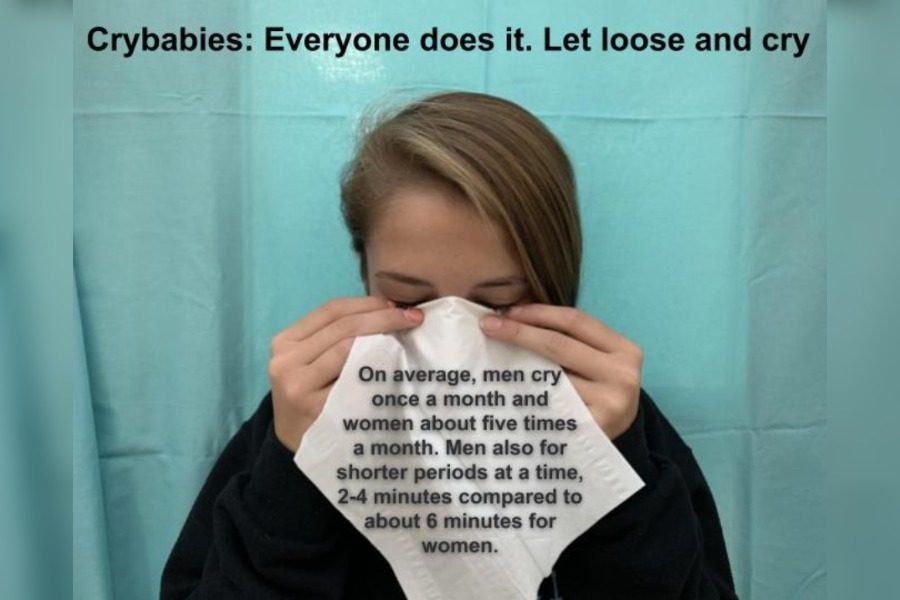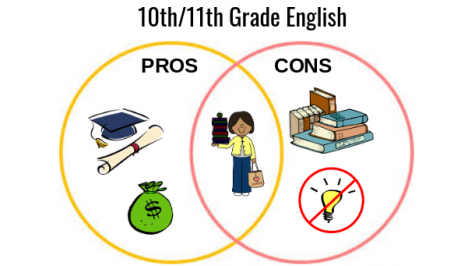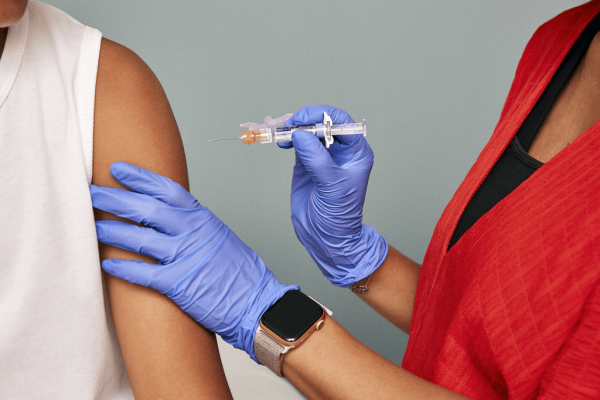Crybabies: Everyone does it. Let loose and cry
Ashley Nash cries over the stresses of school and everyday life. She is not alone–all girls cry. And it is normal!
“I cry because I hold stress inside of me and then when it gets too overwhelming, I have to release it some way.” — Junior Carolina Heister.
“The level of stress sports puts on my mental health plays a toll on how much I cry.” — Junior Madeline Williamson.
“When I am sleep deprived, my world feels like it’s falling apart, and my emotions are overcoming. Crying is just bound to happen.” — Junior Morgan Miller.
“School becomes really overwhelming when I’m trying to keep up with all of my grades because I have so much due at one time, so crying seems like an outlet to release those stresses.” — Junior Lindsey Green.
Do you see yourself in these confessions?
Crying might seem weak and embarrassing, but, in reality, everyone does it. We are born with crying as our first form of communication, but then as we grow up, crying happens less often.
The teenage years bring it back on–for girls, it’s a hurricane of tears.
Crying is a universal, and there is no official standard for a healthy amount of crying. Once a month? Once a week? How about once a day–that’s about right for my friends and me.
So, what is the science of tears? Of the three different types, emotional tears are what you experience when you are having strong feelings. Sadness is registered in the cerebrum. From there, the endocrine system is told to release hormones. This causes us to cry.
As kids grow, their brains morph. The brain areas that process emotions mature very quickly. The prefrontal cortex does not. This means that in our teen years the part of our brain that deals with emotions overpower the other parts of our brains, leaving us more emotional–for some of us, that means puddles of tears.
Grab a tissue, girls. Here’s the sad truth. Women are also biologically wired to shed tears more than men. “Under a microscope, cells of female tear glands look different than men’s. Also, the male tear duct is larger than the female’s, so if a man and a woman both tear up, the woman’s tears will spill onto her cheeks quicker,” reports Katherine Rosman of the Wall Street Journal.
But don’t worry, just because you cry doesn’t mean you are a baby. Your overpowering hormones are out of control. You have a good excuse.
Testosterone, a hormone higher in men, may prohibit crying, while prolactin, which is higher in women, may increase crying. If anything has been affecting your hormones, such as sleep, stress, or medications, it can likely affect how much you cry. This makes sense since we are so stressed and pressured in high school, it’s surprising more teens don’t cry.
When you cry, you activate the parasympathetic nervous system. This system is used to relax your body. The role of the PNS is to slow down your heart rate, increase intestinal and glandular activity, and relax the sphincter muscles.
Your mom might be right. Have a good cry.
Releasing tears have even been found to lower blood pressure and pulse rate. Tears also eliminate harsh chemicals in the body like cortisol that build up during emotional stress. Crying is both a physical and emotional release that helps humans start over, and relook at a situation to feel better without actually doing anything.
“Eighty five percent of women and seventy three percent of men said that they felt better after crying, which shows that tears may help remove chemicals that build up after stress”, according to Frey, a scientist who studies tears.
Teen girls cry over everything. School stress is one of the most common triggers.
An American Academy of Pediatrics (AAP) report suggests that for children and teens, too much work and too little play could backfire. “Colleges are seeing a generation of students who appear to be manifesting increased signs of depression, anxiety, perfectionism and stress.”
We feel a lot of pressure in our lives to live up to our expectations. According to the Pew Research Center, academics tops the list, 61% of teens say they feel a lot of pressure to get good grades. Three-in-ten say also say they feel pressure to look good and fit in socially, while roughly one-in-five feel similarly pressured to be involved in extracurricular activities and to be good at sports. This pressure causes teens to feel stress that they are not good enough or how are they going to ever be able to live up to those expectations.
But, we don’t want you to tell us the solutions that we already know. We just want to cry.
This stress often gets worse by parents pressuring their children to excel in school and sports. This pressure makes failure feel much worse. If you are feeling too much pressure, just think about it. Is this really a life or death situation?
“My mom gives me 30 minutes to cry, but then she says ‘get over it,'” said confirmed crybaby Ashley Martin.
Girls always seem to find themselves caught up in drama. This drama could be springs from many sources. Relationship are top tear-producers–from mean girls and, most commonly, boys. Drama makes many high schoolers go home and cry about not being pretty, smart or just not good enough. People say to not let others affect you, but we all know how that goes.
Teenage girls often feel judged for crying.
Junior Larry Roche said, “I think girls are too emotional sometimes and overreact over the little things.”
This is a common misconception. Girls are so invested in relationships and everything that they do that if something does not go their way, it is really upsetting. The tears start to flow.
“Girls and boys cry about the same amount of times until they reach the age of 12. By the time they are 18, women cry on average four times more than men. That is about 5.3 cries a month compared to a man’s 1.4 times per month” according to research by Dr. William Frey.
Another reason why people cry is that they are afraid of the unknowns. They are so caught up in the moment and don’t ever want anything to change.
Senior Kat Taylor said, “The thought of never seeing some of my friends again after high school makes me really upset.”
Crying does have its benefits. Crying can relieve stress. When you cry you release tears full of stress hormones and “feel good chemicals.” Scientists believe that emotional crying is our body’s way of getting rid of these toxins.
Crying helps to show your feelings and shows emotions which helps us relate to empathize with others and work better in the community. In fact, crying serves an important social function. It can even draw individuals closer to one another, building relationships.
Most people think our sobbing is a sign of weakness. If everyone cries, why is it so hard for it to seem normal to see someone crying?
“I hate when girls cry,” said William Quansah. He’s right. It’s hard to know what to do.
But as much good as Crying does, it’s not the only option to overcome the challenges of your teenage years. Next time you are upset, try catching your breath and take a break, you could try to talk it out with a friend. Teens could try exercising and even sleep might help. But remember crying is not a bad thing and everyone does it.
Even though most girls cry in high school, it can also be a sign of depression and it is important to know the signs. A teen stops doing things she usually likes to do. There might be changes in mood, including sadness or irritability. Decreased appetite or energy level, changed sleep patterns and school performance are all signs. If several of these symptoms apply to you, talk to a trusted adult or doctor.
Your donation will support the student journalists of Linganore High School. Your contribution will allow us to purchase camera/recording equipment and software. We hope to raise enough money to re-start a monthly printed issue of our paper.














Leslie Parente • Oct 22, 2019 at 5:24 am
I really enjoyed reading this article. Very interesting! Keep the stories coming!
Mary Jo York • Oct 21, 2019 at 2:54 pm
I LOVED this article! Thank you for writing it!